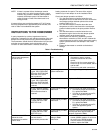
D896 AUTOMATIC VENT DAMPER
68-0186
11
EXHIBIT B
Procedure for Installing Electrically Operated Automatic Vent Damper Devices on Existing Appliances
This procedure is intended as a guide to aid in safely
installing an electrically operated or mechanically actuated
automatic vent damper device on an existing appliance.
This procedure is based on the assumption that the history of
the specific appliance has been one of safe and satisfactory
operation.
This procedure is predicated on central furnace, boiler and
water heater installations, and it should be recognized that
generalized procedures cannot anticipate all situations.
Accordingly, in some cases deviation from this procedure may
be necessary to determine safe operation of the equipment.
The following steps are to be followed in making the
modifications:
1. Perform a safety inspection of the existing appliance
installation. See Exhibit A for the recommended
procedure for such a safety inspection.
2. Shut off all gas and electricity to the appliance.
To shut
off gas use the shutoff valve in the supply line to the
appliance.
3. Install the automatic vent damper device in strict
accordance with the manufacturer’s installation
instructions. Make certain the device is not located in
that portion of the venting system which serves any
appliance other than the one for which the damper is
installed.
4. Make certain wiring connections are tight and wires are
positioned and secured so they will not be able to
contact high temperature locations.
5. When an additional automatic valve has been
incorporated or an existing gas control replaced,
conduct a gas leakage test of the appliance piping and
control system downstream of the shutoff valve in the
supply line to the appliance.
6. Visually inspect the modified venting system for proper
horizontal pitch.
7. Check that the damper and gas valve(s) are in the
correct operating sequence.
(a) The damper must be in the full open position
before the gas valve(s) opens.
(b) The damper must remain in the full open position
while the gas valve(s) is open.
(c) The gas valve(s) must be closed before damper
begins
its return to the closed position.
(d) The damper shall remain in the closed position
during the off cycle of the appliance.
8. Determine the amperage draw of the gas control circuit
and damper device.
(a) Check appliance transformer for adequate
capacity.
(b) Check heat anticipator in comfort thermostat to
determine if it is properly adjusted.
9. Sequence the appliance through at least three normal
operating cycles.
10. Insofar as is practical, close all building doors and
windows and all doors between the space in which the
appliance is located and other spaces of the building.
Turn on clothes dryers. Turn on any exhaust fans, such
as range hoods and bathroom exhausts, so they will
operate at maximum speed. Do not operate a summer
exhaust fan. Close fireplace dampers.
11. Place appliance in operation.
Follow the lighting
instructions.
Adjust thermostat so appliance will operate
continuously.
12. Test for spillage at the draft hood relief opening after 5
minutes of main burner operation. Use the flame of a
match or candle, or smoke from a cigarette, cigar or
pipe.
13. (a) Visually determine that main burner gas is burning
properly; i.e., no floating, lifting or flashback. Adjust
the primary air shutter(s) as required.
(b) If the appliance is equipped with high and low
flame controlling or flame modulation, check for
proper main burner operation at low flame.
14. Determine that the pilot(s), when provided, is burning
properly and that main burner ignition is satisfactory by
interrupting and reestablishing the electrical supply to
the appliance in any convenient manner.
If the appliance is equipped with a continuous pilot(s), test the
pilot safety device(s) to determine if it is operating properly by
extinguishing the pilot(s) when the main burner(s) is off and
determining, after 3 minutes, that the main burner gas does
not flow upon a call for heat.
If the appliance is not provided with a pilot(s), test for proper
operation of the ignition system in accordance with the
appliance manufacturer’s lighting and operating instructions.
15.
Applicable only to furnaces
—Check both the limit
control and the fan control for proper operation. Limit
control operation can be checked by blocking the
circulating air inlet or temporarily disconnecting the
electrical supply to the blower motor and determining
that the limit control acts to shut off the main burner
gas.
16.
Applicable only to boilers
—
(a) Determine that the water pumps are in operating
condition.
(b) Test low water cutoffs, automatic feed controls,
pressure and temperature limit controls, and relief
valves in accordance with the manufacturer’s
recommendations to determine they are in
operating condition.
17. Label the damper device (see 1.7.5) with information as
to:
(a) Name of qualified agency responsible for damper
installation.
(b) Date of installation.
Exhibit B of ANSI Standard Z21.66-1994 for Electrically Operated Automatic Vent Damper Device
for use with Gas-Fired Appliances.














